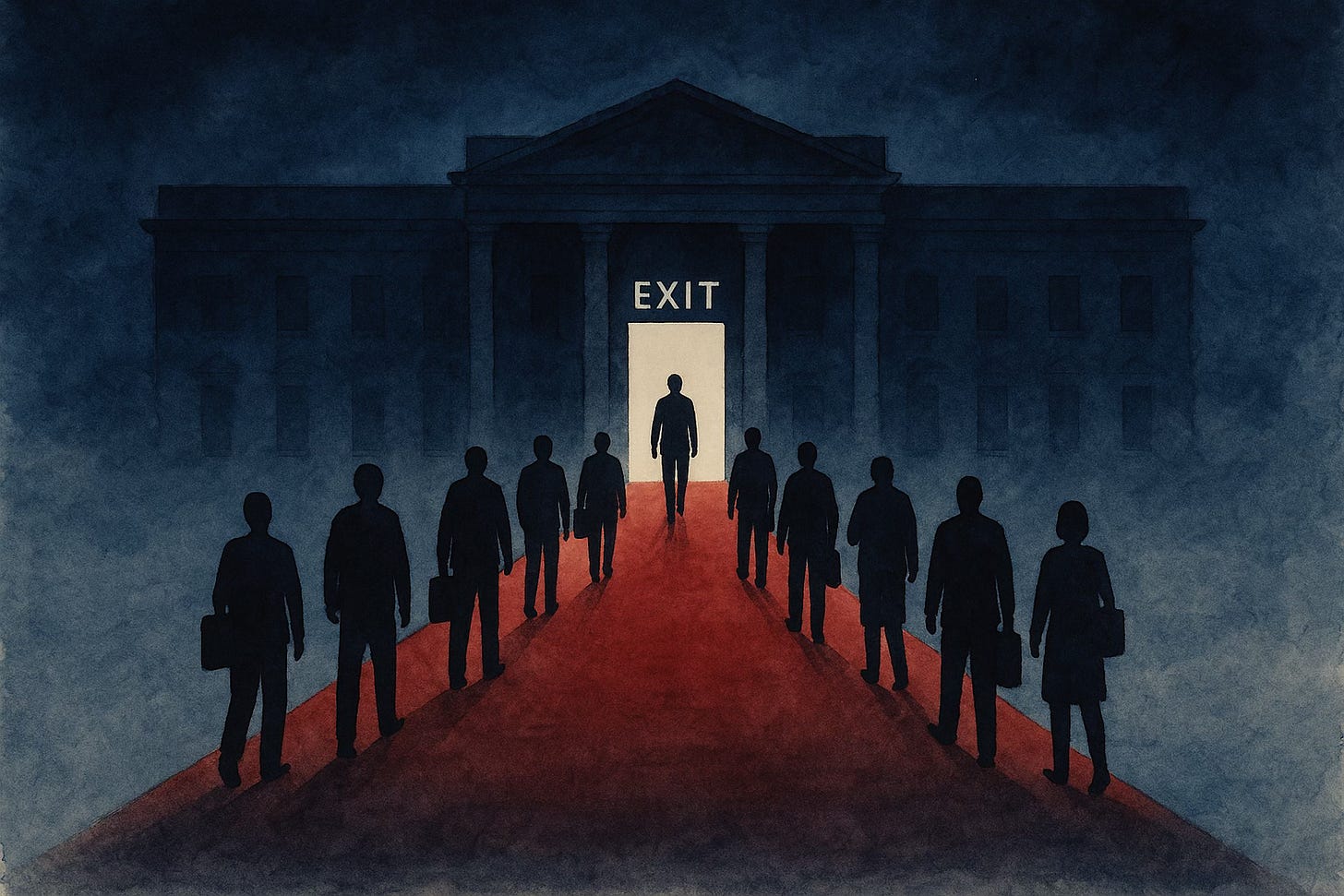Exit America: Paying People Not to Work
Trump’s deferred resignation plan is the most expensive purge in federal history
The government didn’t right-size itself this week. It paid for a purge.
154,000 career employees left in one coordinated wave. Biggest single-year loss since World War II. Not a rumor.
Deferred Resignation Program
Say yes. Stop working. Keep salary and benefits. Resign on a fixed date. USDA’s second round drew 16,000 signups. HHS published an explainer with the terms. Retirement alignment. Ethics guardrails for outside work. Everything spelled out.
No one hid the incentives. Take guaranteed money now. Avoid shutdown roulette later. Pocket months of pay while you line up the next job. That is how you get a stampede.
The carrot sat next to two sticks.
First, an order and a proposed rule that reclassify thousands of policy-influencing roles. Less due process. More at-will risk.
Second, a throttle on hiring. One hire for every four departures. Narrow exceptions. Add a shutdown threat. The rational move is obvious. Take the buyout.
There is data for the behavior. Workers hit by a shutdown are 31 percent more likely to quit within a year.
The sales pitch said the program pays for itself. It does not. The paid-leave bill is $14.8 billion. On top of that sits $21.7 billion in waste tied to the broader downsizing push. Reinstatements. Severance. Bungled removals. Add them. About $36.5 billion out the door to unlock future savings that have not been shown with a transparent method anyone can test.
Meanwhile the core federal workforce still hovers around 2.3 to 2.4 million non-Postal employees. A fast cut of that size is not just a smaller payroll. It is a shift to contractors at a premium or a quiet admission that some work will not get done.
Paying hundreds of thousands of people for months not to work is a cost. It is already booked.
If you want a control case, go back to 2019. USDA moved the Economic Research Service and NIFA to Kansas City. Senior staff left. Reports slipped. Grants lagged. The workforce and productivity fell. Recovery took years and the bench came back greener. Today’s scale is far larger. NASA. The Weather Service. USDA again. CDC. FDA.
Let’s steelman the counterargument before it collapses. Government is bloated and slow. Elections should translate into policy execution, not a permanent veto by career staff. Reclassification promises accountability. The DRP is a clean off-ramp, kinder than removals. Federal compensation is a massive line item. Voters say they want smaller government. All fair points.
Now the receipts that matter:
First, the savings claim is unsubstantiated. The costs are not. You can wave a model on TV. You cannot skip the ledger. $14.8B paid for people not to work. $21.7B in collateral waste. Real outflows.
Second, selection effects hit the wrong layer. The people who can leave on a dime tend to have options. They are often the highest-skill, highest-discretion tier. Agencies then buy back similar capacity from contractors with a margin on top. Or they live with degraded service.
Third, morale shocks compound attrition. Exposure to shutdown risk raises departures. Pair that with at-will conversion and one-in-four hiring. You lock in a lower baseline. You do not build a lean machine. You build a brittle one.
Fourth, rules matter. Strip away Chapter 43 and 75 protections for a wide class of policy roles and you do not get neutral accountability. You get politicization by design. Be honest about the trade.
Expertise density is the constraint that breaks first. Disability adjudication runs on a few case-law savants who keep the error rate tolerable. Air traffic modernization runs on a handful of engineers who know where the bodies are buried in old code. Food safety hinges on inspectors and analysts who have seen the edge cases. DRP plus at-will reclassification plus one-in-four hiring thins exactly that layer. Thinner expertise means slower decisions. More errors. More headlines about backlogs. Then more contractors to clean up the mess, which makes the savings boomerang.
There is a procurement risk in the fine print. DRP participants could take private jobs while still on paid leave if they stayed within ethics limits. That sounds tidy. In practice, it invites bid protests that allege unfair advantage or organizational conflicts when those hires shape capture strategy. Protests mean months of delay. Lawyers get paid. Taxpayers do too, just not in the way they were promised.
If you want the through line, it is three gears that mesh.
Carrot: DRP cash and time to land elsewhere.
Stick: reclassification that trims due process for policy roles.
Throttle: one hire for every four departures.
On paper, tidy. In practice, costly up front and brittle over time. The promised savings do not show up in the public math. The costs already have.
What’s Next to Watch
Court fights that will test whether the reclassification rule actually sticks.
Real-world service metrics — SSA wait times, VA backlogs, FDA inspections — the canaries in the coal mine.
Contractor surges and bid protests over DRP hires that could jam the system.
USDA’s next realignment wave, déjà vu all over again.
Dig Deeper:
Reuters — U.S. government faces brain drain as 154,000 federal workers exit this week
Bloomberg Law — Trump Spent $14.8 Billion for Federal Employees to Stay Home
Federal Register — Executive Order 14171: Restoring Accountability to Policy-Influencing Positions
The White House — Fact Sheet: President Donald J. Trump Extends the Hiring Freeze
GAO — USDA Research Agency Relocations: Workforce and Productivity Impacts
UVA Darden — How the “Blunt Shock” of Government Shutdowns Demoralizes Workers
FRED (BLS) — All Employees, Federal, Except U.S. Postal Service (CES9091100001)
Government Executive — Employees swarm to second ‘deferred resignation’ offer




You have made your case and then some!